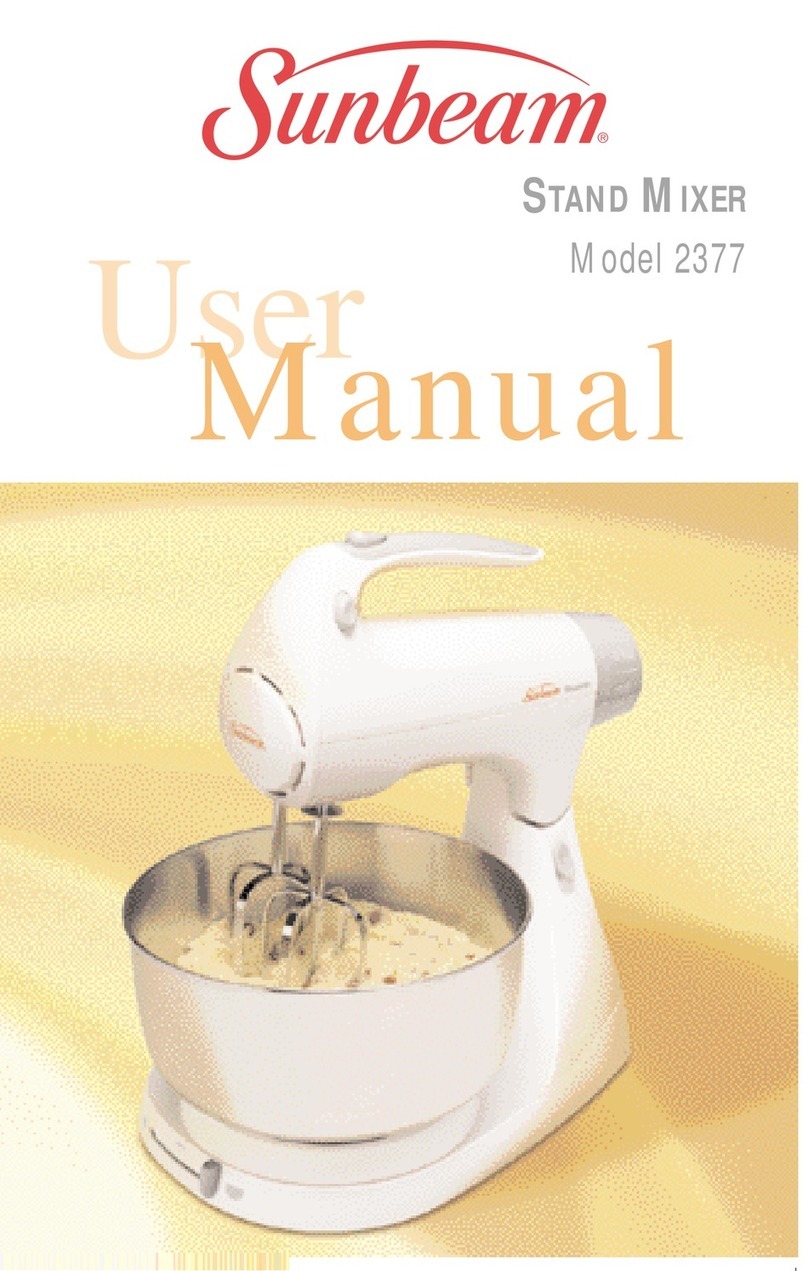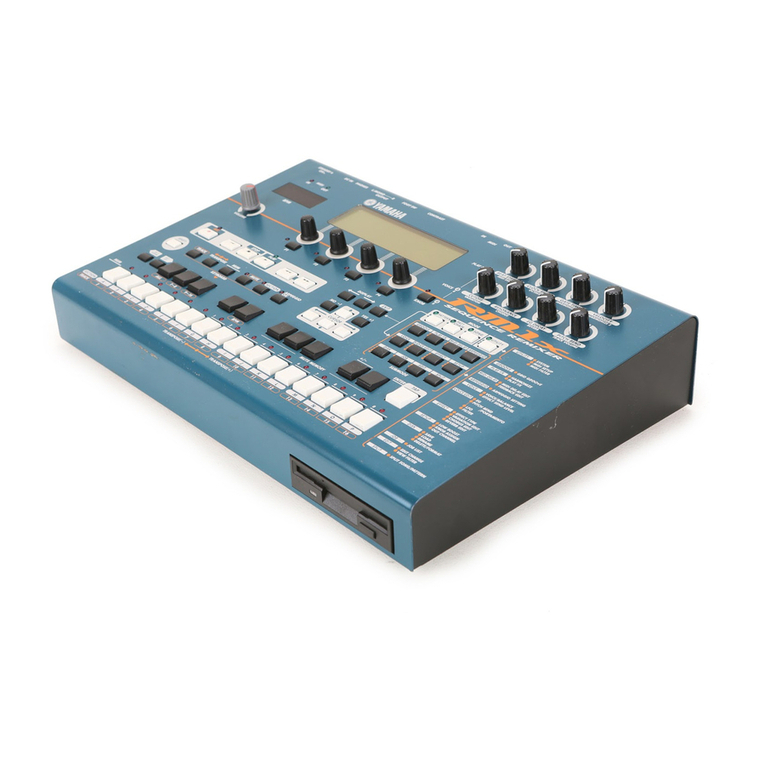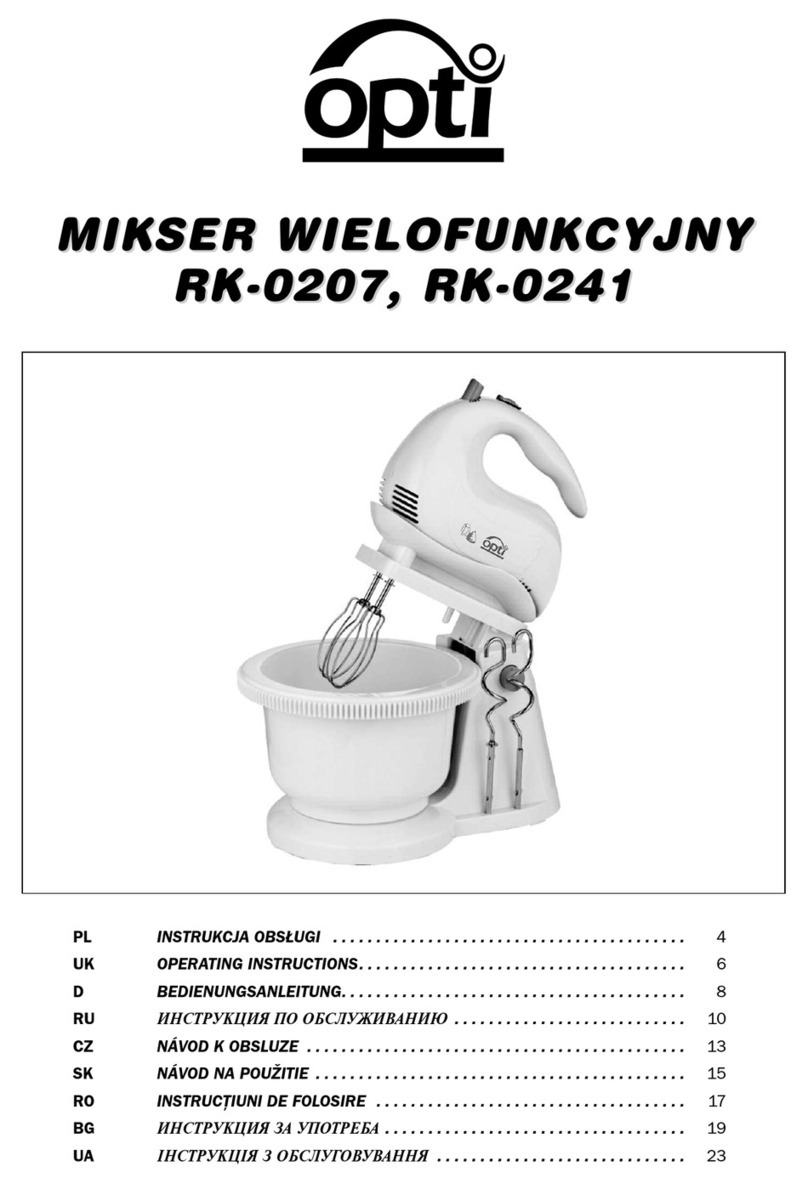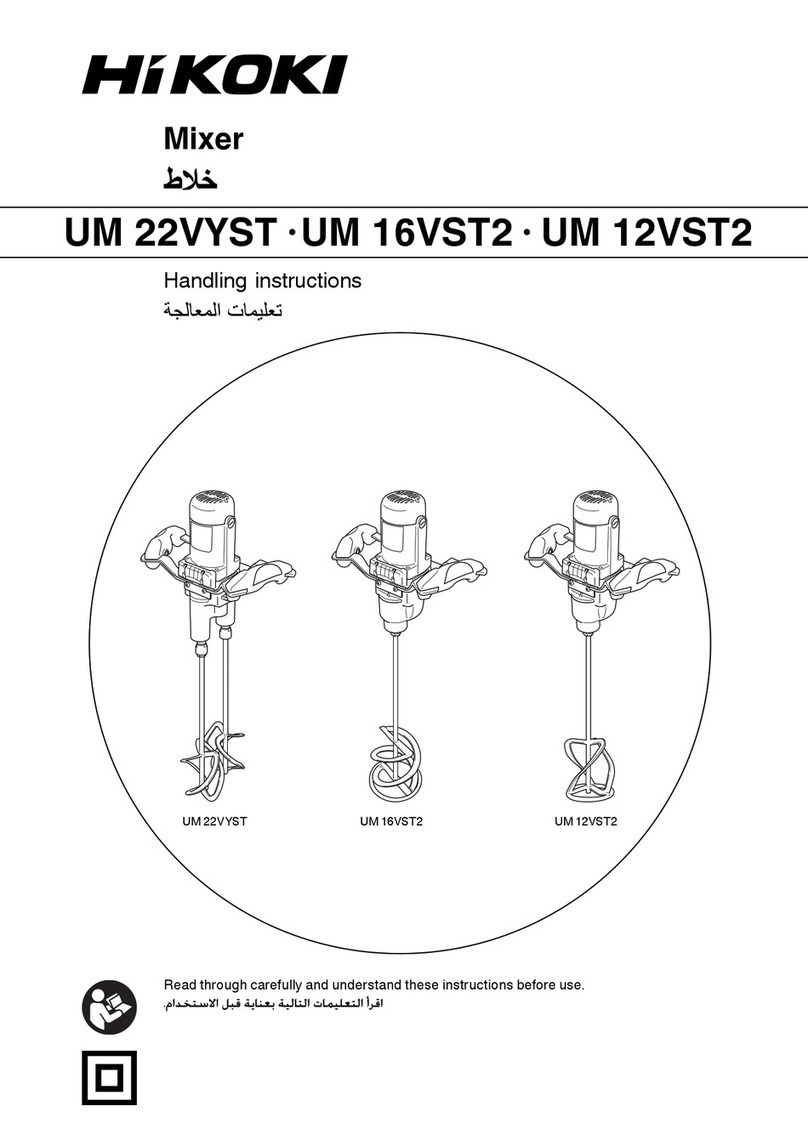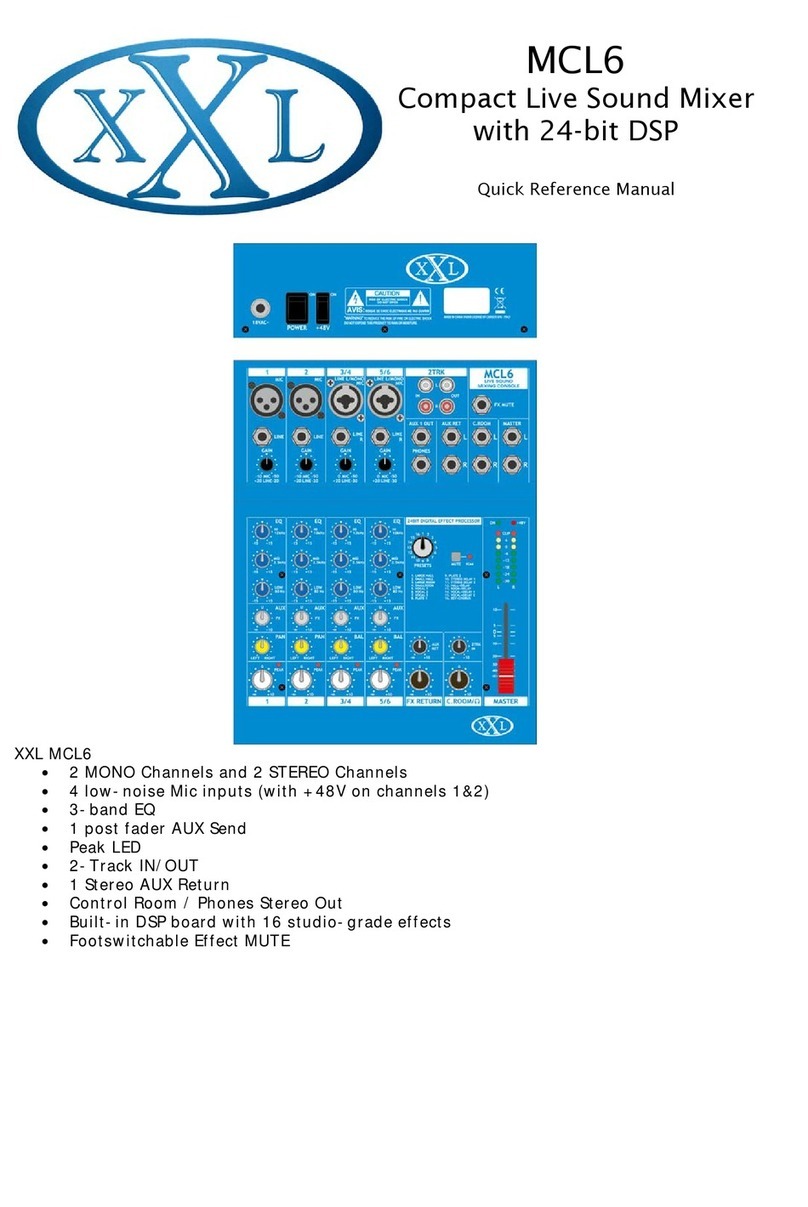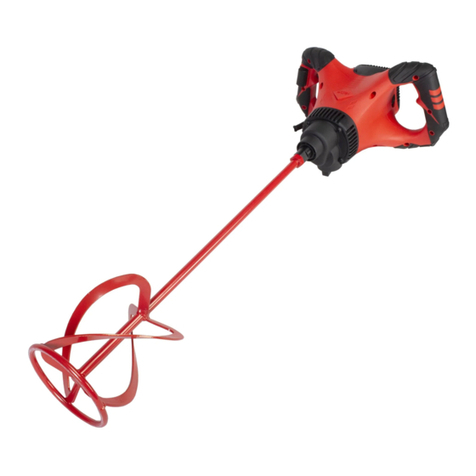Rodec MX1800 User manual

USER MANUAL
RODEC

2

3
Electromagnetic and safety compliances
This product complies with the European Electromagnetic Compatibility
directives 89/336/EEC & 92/31/EEC and the European Low Voltage
Directives 73/23/EEC & 93/68/EEC.
This product is in conformity with the following specifications
NEN-EN 55103-1 Electromagnetic compatibility.
Product family standard for audio, video, audio- visual
entertainment lighting control equipment for professional
use. Part 1: Emission. (September 1995)
NEN-EN 55103-2 Electromagnetic compatibility.
Product family standard for audio, video, audio- visual
entertainment lighting control equipment for professional
use. Part 2: Immunity. (September 1995)
following the provisions of Council Directive 89/336/EEC on the approximation of the
laws of the Member States relating to electromagnetic compatibility
This product is designed to comply with the following standards:
UL 60950 3rd edition (2000) standard
TUV EN 60950 : 1992+A1+A2+A3+A4+A11 (1997) standard

4
IMPORTANT SAFETY INSTRUCTIONS
PLEASE READ INSTRUCTIONS BEFORE OPERATING THE EQUIPMENT
1) For your own safety, please read the user manual before operating or connecting the unit.
2) The user manual must be in possession of the owner of the mixing panel. This manual
must be kept on a safe place for future reference.
3) The mixing panel must always be connected to a mains power supply net with appropriate
grounding. This is necessary for the optimal working of the mixing panel and to assure the
safety of the user.
4) Always handle the power cord by the plug, do not pull the cord. Do not use broken or
damaged power cord or plug. Damaged power cords or plugs can cause fire or create
shock hazard.
5) Do not open the set; there are no serviceable parts inside. Only qualified service
technicians can service inside your set.
6) Do not expose to rain or water. Do not spill liquid or insert (metal) objects inside the set.
Rain, water or liquid such as cosmetics as well as metal, may cause electric shocks, which
can result in fire or shock hazard. If anything gets inside, immediately unplug the power
cord.
7) If the mixing panel is not used for a longer period (more than one day), please disconnect
the power cord from the mains net. Switching off the power switch does not completely
turn the mixing panel off.
8) WARNING! The sound and intensity volume of this product can be very strong and, if not
used properly, or if used in too close proximity, can cause temporary or permanent
damage to one’s hearing, perhaps even deafness. Use with caution and common sense.
INSTALLATION OF THE MIXING PANEL
1) The set can be used in every position.
2) Do not place the set into direct sunlight, or in a warm moist or dusty place. The operating
environment temperature should be between +5°C and +35°C. The relative humidity of the
air should be below 85%.
3) Always place the unit in a well-ventilated area.
4) To avoid disturbances, do not place the set near disturbing equipment, such as
transmitters, cell-phones, electro-motors, etc.
5) Avoid dust (like ashes from cigarettes) to fall on the mixing panel. Also avoid smoke from
(for instance smoke machines or cigarettes) entering the unit. Smoke will accelerate wear
on the electronic circuits, potentiometers and faders of the mixing panel.
6) Do not place heavy or sharp objects on the mixing panel, these can damage the knobs,
switches, LEDs, etc..
7) Manipulate the console with care. Avoid abrupt movements of the controls.
8) If the mixing panel has to be transported, please use the original packaging or use an
appropriately built flight case. Avoid shocks.
CLEANING OF THE MIXING PANEL
1) Do not use chemical products or solvents to clean the set. To clean the mixing panel, it is
best to use a soft brush or a dry lint-free cloth.
2) Do not use contact spray or other products in the faders. The contact spray can damage
the faders.

5
Congratulations with the purchase of a RODEC MX1800 mixing panel!
You are the owner of a top-line mixing panel, capable of outstanding performance in
combination with other high-grade systems.
RODEC mixing panels have a well established reputation for high quality, robustly
built, good sounding audio equipment. The RODEC mixers are used in the biggest
discotheques worldwide, by the most famous DJ’s and in the largest rental companies
all over the world.
Now, the new top-line series were designed and built with the same precision and
devotion as known for years. The well-known analogue sound is kept, completed with
some new digitally controlled features and I/O.
The total setup of the mixing panel is described in this user manual, all connectors and
controls are explained on the next pages. Also different application setups are quoted
here.
Further information about this mixing panel can be found on our website:
http://www.rodec.com
For questions, more information or service of your mixing panel, contact the distributor
or service center in your country. We possess a widely branched network of
distributors and service centers worldwide. The RODEC distributor list can be found
on our website http://www.rodec.com
Please always mention serial number, date and place of purchase for all matters
concerning service.
MODEL MX1800
SERIAL NUMBER …………………………… (on the back of the set)
Although this manual is compiled with greatest precision, we do not assume
responsibility for inaccuracies. Updates or modifications can be applied without prior
notice.

6
Table of contents
Page:
Electromagnetic and safety compliances ……………………………………….…... 3
Safety instructions ……………………………………………………………………… 4
Introduction ……….…………………………………………………………………….. 5
Table of contents ………………………………………………………………………. 6
Frontpanel with controls ………………………………………………………………. 7
Backpanel with connectors …………………………………………………………… 13
Cable configurations …………………………………………………………………… 16
Different audio connectors …………………………………………………….. 16
Different audio cables ………………………………………………………….. 16
Operating instructions ………………………………………………………………….. 19
Subsonic filter ……………….………………………………………………….. 23
Application examples …………………………………………………………………... 24
Options …………………………………………………………………………………… 29
USB input/output option …………………………………………………….…… 29
Alarm / music mute priority in option ………………………….………….……. 29
Digital optical 60mm channel fader ……………………………….…..….……. 29
Digital optical 45mm crossfader ……………………………………...….…….. 30
Standard knobs set MX00 series ……………………………………………… 30
Fader knobs BX/CX/MX MKIII/MX00 series …………………………………. 30
Specifications ……………………………………………………………………………. 31
Explanatory words list ………………………………………………………………….. 33

7
Frontpanel with controls
XY
RODEC
9
14 19 20
12
10
15 16 17 18
1311
27
26
25
24
28
31
32
30
298
7
6
4
3
2
1
5
23
22
21
1) Input select switch
This selector is used to select the input signal: MICRO, PHONO, LINE A or LINE B.
2) Input level potentiometer
With this control the input level of each input channel can be set.
3) Equalizer controls
These controls regulate the amount of treble, middle and bass in the sound.

8
-24
+14
-22
-20
-18
-16
-14
-12
-10
-8
-6
-4
-2
+0
+2
+4
+6
+8
+10
+12
d
B
r
20 20k50 100 200 500 1k 2k 5k 10k
Hz
LOW MAX
LOW MIN
MID MAX
MID MIN
HIGH MAX
HIGH MIN
4) Input channel effects assign indication LED’s
These LED’s indicate which channel is routed trough one of the effects outputs. If the FX-1 and
FX-2 LED’s do not light up, no channel is routed via the effects. If the FX-1 LED of a channel
lights up green, that channel is routed via effects output 1. If the FX-1 LED of a channel lights
up red, one of the other channels is routed via FX-1 and no other channel can be routed via
FX-1 at that moment.
Same counts for the FX-2 LED that lights up. If the FX-1 LED is blinking red, the input channel
effects assign potentiometer (5) must be turned back to its center position because it was
initially placed in a fault position.
5) Input channel effects assign potentiometer
With this control, the input signal can be routed via effects output 1 or 2. When the knob is
placed in the center (12 o’clock) position, the signal goes straight to the main mix without
passing via one of the effects-outputs. When the knob is turned to the left, the signal will go via
the effects 1 output. When the knob is turned to the right, the signal will go via the effects 2
output. The proportion between the dry (no effect) and wet (100% effect) can be set with the
potentiometer.
6) Balance control
The balance between the amount of sound on the left and on the right is adjusted by using this
knob. When it is set to the center position, the gain is the same for both the left and the right
channel. When turned to the left, the right channel will decrease. When turned to the right, the
left signal will decrease.
7) Routing selector
With this selector the signal can be lead: to the left side of the crossfader (X), directly to the
output (MIX) or to the right side of the crossfader (Y).
8) PFL switches
With these switches you can select the different input sources that you will listen to with the
headphones.

9
9) Channel faders
Volume control for every input channel.
10) Equalizer
Triple tone control for DJ microphone.
-30
+15
-27.5
-25
-22.5
-20
-17.5
-15
-12.5
-10
-7.5
-5
-2.5
+0
+2.5
+5
+7.5
+10
+12.5
d
B
r
20 20k50 100 200 500 1k 2k 5k 10k
Hz
LOW MAX
LOW MIN
HIGH MAX
HIGH MIN
MID MAX
MID MIN
11) DJ microphone input level potentiometer
Control for accurate level-adjustment of different types of microphones.
12) Talk-over control
Control for the amount of music suppression controlled by the DJ microphone signal.
13) VU meters
The two left meters indicate the PFL signal. The right VU-meter displays the output signals,
depending on the position of the VU-2 signal select switch (27).
14) Crossfader
With this fader you can easily fade over between the channels with routing-selector (7) on X-
position and the channels with routing-selector (7) on Y-position. When the knob is turned
completely to the left, the signal of the channels with routing selector (7) on X will appear on the
output. When the knob is turned completely to the right, the signal of the channels with Routing
selector (7) on Y will appear on the output. In between there will be a mix of both signals.
15) DJ microphone fader
Volume control for DJ microphone
16) DJ microphone PFL switch
With this switch the microphone signal can be made audible in the headphones and made
visible on the left VU-meters.

10
17) Pan Mic
Panoramic control for DJ microphone input. With this button you can position the microphone
signal between the left and right loudspeaker.
18) Power "ON" indicators
These indicators light up when the power is on.
19) Master 1 and master 2 output fader
Volume controls final output of mixer towards slave or integrated amplifiers.
20) Monitor output fader
Volume control for the signal level for the monitor output, this output does not contain the DJ-
mic signal to avoid feedback of the microphone-signal via the monitor loudspeakers.
21) Monitor equalizer controls
Bass and treble adjustment for the monitor output.
-20
+20
-18
-16
-14
-12
-10
-8
-6
-4
-2
-0
+2
+4
+6
+8
+10
+12
+14
+16
+18
d
B
r
20 20k50 100 200 500 1k 2k 5k 10k
Hz
LOW MAX
LOW MIN
HIGH MAX
HIGH MIN
22) Monitor mode Switch
This switch is used to set the monitor output in mono or stereo mode.
23) Master 1 and master 2 mode Switch
This switch is used to set the master 1 and 2 outputs in mono or stereo mode.
24) Record Select
This switch is used to make recordings with or without the DJ microphone.
+ DJ MIC: in this position you add the DJ mic signal to the music.
- DJ MIC: in this position you only record the signal from channel 1 - 4.
This switch has no influence on the master outputs.
25) Main mix effects assign indication LED’s
These LED’s indicate if the main mix signal is routed through one of the effects outputs. If the
FX-1 and FX-2 LED’s do not light up, the main mix signal is not routed via the effects. If the FX-
1 LED lights up green, the main mix signal is routed via effects output 1. If the FX-1 LED lights

11
up red, an input channel’s signal is routed via FX-1 output and no other channel can be routed
via FX-1 at that moment.
Same counts for the FX-2 LED that lights up. If the FX-1 LED is blinking red, the main mix
effects assign potentiometer (26) must be turned back to its center position because it was
initially placed in a fault position.
26) Main mix effects assign potentiometer
With this control, the main mix signal can be routed through effects output 1 or 2. When the
knob is placed in the center (12 o’clock) position, the signal goes straight to the main mix
without passing through one of the effects-outputs. When the knob is turned to the left, the
signal will go through the effects 1 output. When the knob is turned to the right, the signal will
go through the effects 2 output. The proportion between the dry (no effect) and wet (100%
effect) can be set with the potentiometer.
27) VU-2 signal select switch
With this switch is it possible to select the signal displayed on the two right VU-meters. When
the switch is on the SUM position the mix-signal will be displayed. On the positions MASTER 1,
MASTER 2 and MONITOR the according output signals will be displayed.
28) Alarm/music mute indicator LED
This LED indicates the amount of music suppression due to the control signal on the optional
alarm/music mute input. When the LED doesn’t light up, the music is not suppressed. When the
LED lights up at full power, the music is fully suppressed.
29) Headphones-select potentiometer
With this potentiometer, the signal for the headphones output can be selected. When turned
completely to the left, the signal selected with the channel PFL-switches (8) appears on the
headphones. When turned completely to the right, the mix-signal appears on the headphones.
In between it results in a mix of the PFL-signal and the mix-signal.
30) Headphones volume control
The volume of the headphones can be adjusted with this knob.
WARNING! The sound and intensity volume of the headphones amplifier can be very
strong and, if not used properly, or if used in too close proximity, can cause
permanent or temporary damage to one’s hearing, perhaps even deafness.
Please use with caution and common sense!
31) Phones output
Output for high level headphones monitoring. With the PFL switches (8 or 16) and the
headphones-select potentiometer (29), the connected audio sources or the main-mix can be
made audible without manipulating the output signal (Headphones 32-600Ω).
ATTENTION! Always turn headphones volume to “0” (fully counter clockwise) BEFORE
putting the headphones on your or somebody else her/his ears! Then
slowly raise the volume by turning the volume knob in clockwise direction.
32) Cross fader curve potentiometer
This potentiometer is used to set the sharpness of the cross fader. When the potentiometer is
turned completely to the left, the cross fader (14) will react as a normal cross fader. The
volumes of the channels with routing-selector (7) on Y-position will rise from 0 to maximum
when the shaft of the cross fader is moved from the left to the middle. The same counts for the
volumes of the channels with routing-selector (7) on X-position, but then from the right side to
the middle.

12
When the curve potentiometer is turned to the right, the cross fader will react very fast, with the
volumes of the channels with routing-selector (7) on Y-position rising from 0 to maximum when
the shaft of the cross fader is moved from the left to a few fractions from the left. The same
counts for the volumes of the channels with routing-selector (7) on X-position, but then from the
right side to a few fractions from the right side.

13
Backpanel with connectors
KLM
A B
QPN O
EDC F G H
UWV
I J
STR
www.rodec.com
RODEC
Made in B elgium
Professional
Audio Equipment
WARNING
DISCONNECT POWERCORD
BEFOREOPENING
PS
E
A) Power switch
Controls the supply of AC power to the set. One push turns the mixing panel on, a second push
turns it off.
Attention! By turning off this switch, the mixing panel is in stand-by mode. At that moment
the mixing panel will still consume electricity from the mains net. The power
cord has to be unplugged from the power inlet to shut down all power.
B) Effects IN/OUT 1
In- and output to connect effect equipment to the music signal. The signal that runs through this
connector is controlled by the input channel effects assign potentiometer (5) or main mix effects
assign potentiometer (26). Internally linked when JACK is not inserted. Sensitivity 775mV.
C) Symmetrical monitor output
Additional output up to 1.55V controlled by monitorfader (20). The DJ-microphone signal does
not appear on this output.
D) Symmetrical master output 2
Symmetrical output to connect power-amplifier or loudspeaker-processor. The output level can
be manipulated with master fader 2 (19) from 0 to maximum (1.55V).
E) Symmetrical master output 1
Symmetrical output to connect a power-amplifier or loudspeaker-processor. The output level
can be manipulated with master fader 1 (19) from 0 to maximum (1.55V).
F) DJ microphone input
Balanced microphone input with a sensitivity of 4.2mV, with XLR-JACK combination connector.
G) Effects IN/OUT
Input and output to connect effect equipment to the microphone channel. If there is no plug in
the JACK connector, the microphone channel works normally, if there is a plug inserted in the
JACK, the internal link is interrupted. The sensitivity of this IN/OUT connection is 775mV.
H) Ground-terminal
Terminal to connect the ground wire of the vinyl turntable.

14
I) Micro input
Balanced microphone input. To obtain good signal quality, you have to use a microphone with
balanced output. The use of a microphone without balanced output is also possible.
J) PHONO input
Phono input with a sensitivity of 5.2mV and built in RIAA correction.
-20
+20
-18
-16
-14
-12
-10
-8
-6
-4
-2
-0
+2
+4
+6
+8
+10
+12
+14
+16
+18
d
B
r
20 20k50 100 200 500 1k 2k 5k 10k
Hz
K) Asymmetrical master output 1
Asymmetrical output to connect a power-amplifier. The output level can be manipulated with
master fader 1 (19) from 0 to maximum (0.775V).
L) Second headphones connector
Signal identical as headphones-output on the frontpanel (31). The specifications are the same
as the headphones output on the frontpanel.
M) Effects IN/OUT 2
In- and output to connect effect equipment to the music signal. The signal that will run through
this connector is controlled by the input channel effects assign potentiometer (5) or main mix
effects assign potentiometer (26). Internally linked when JACK is not inserted. Sensitivity
775mV.
N) Alarm / music mute in connector
Optional 4-pole connector to mute or turn off the music signal remote controlled. The DJ
microphone signal will keep on working normally when the music is muted by the signal on this
connector.
O) Priority signal input
Optional input to connect a signal coming from an evacuation-message player, alarm-signal
generator, etc. This signal can be played at the moment when the other music signals are
muted by the signal on the alarm / music mute connector.

15
P) Priority signal input level potentiometer
With this control the input level of the priority signal (O) can be set.
Q) Power inlet
Universal mains power inlet.
R) Digital recording output
Output to connect to a S/P DIF input of a MD-recorder, CD-recorder, HD-recorder or DAT-
recorder to make recordings. This output can be switched with or without recording the DJ
microphone signal (24). Both signals (left and right) go through one connector. (Only provided
on channels 1 and 4)
S) USB input/output
Optional USB connector to play music from PC or HD-player and simultaneously record the
main mix signal with a PC or HD-recorder. All 4 signals (reproduction left and right and
recording left and right) go through one connector. (Only possible on channels 1 and 4)
T) Digital line input B
Digital S/P DIF input, to connect different equipment such as a CD player, MD player, DVD
player, MP3-player, HD-player or digital tuner. Both signals (left and right) go through one
connector. (Only provided on channels 1 and 4)
U) Analogue recording output
Output to connect analogue recording device or (HIFI) video recorders to make recordings. This
output can be switched with or without recording the DJ microphone signal (24). (Only provided
on channels 2 and 3)
V) Analogue line input B
Analogue asymmetrical input with a sensitivity of 500mV, to connect different equipment such
as a CD player, MD player, DVD player, MP3-player, HD-player, analogue - or digital tuner,
cassette player or video player. (Only provided on channels 2 and 3)
W) Analogue line input A
Analogue asymmetrical input with a sensitivity of 500mV, to connect different equipment such
as a CD player, MD player, DVD player, MP3-player, HD-player, analogue - or digital tuner,
cassette player or video player.
Please use signal cables shorter than 1 meter for the inputs and the outputs.

16
Cable configurations
a) Different audio connectors
Tip
Sleeve Tip
Tip
RingSleeve
Sleeve
RCA (Cinch) male JACK 3 pole 1/4 inch male
JACK 2 pole 1/4 inch male
XLR 3 pole female
Pin 2 Pin 1
Pin 3
XLR 3 pole male
Pin 1
Pin 3
Pin 2
USB B male
Pin 2
Pin 1
Pin 3
Pin 4
USB A male Pin 1
Pin 3
Pin 4 Pin 2
PHOENIX 4 pole female
b) Different audio cables
1) Asymmetrical RCA cable:
Asymmetrical
RCA male
A
symmetrical
RCA male
Used for connections between: CD-player, MD-player/recorder, Vinyl turntable, DVD-
player/recorder, amplifier, etc. and mixing panel.
For connections of analogue signals, you need 2 of these cables for stereo
For connections of digital S/P DIF, you need only 1 cable for stereo
2) Symmetrical XLR cable:
Symmetrical
XLR 3 pole female
Symmetrical
XLR 3 pole male
12
3
12
3
Used for connections between: microphone, amplifier, equalizer, loudspeaker-processor, limiter,
etc. and mixing panel.
For connections of analogue signals, you need 2 of these cables for stereo

17
3) Symmetrical XLR female to JACK 3pole male cable:
Symmetrical
XLR 3 pole female
Symmetrical
JACK 3 pole 1/4 inch male
12
3
Used for connections between: microphone, amplifier, loudspeaker-processor, etc. and mixing
panel.
For stereo connections, you need 2 of these cables
4) Asymmetrical JACK 2 pole male to RCA male cable:
Asymmetrical
JACK 2 pole 1/4 inch male
A
symmetrical
RCA male
Used for connections between: electronic musical instrument, synthesizer, sampler, effects-
machine, amplifier, recorder, etc. and mixing panel.
For stereo connections, you need 2 of these cables
5) Symmetrical XLR female to asymmetrical RCA male cable:
Symmetrical
XLR 3 pole female
A
symmetrical
RCA male
12
3
Used for connections between: professional CD-player, professional MD-player, sampler, effects-
machine, etc. and mixing panel.
For stereo connections, you need 2 of these cables
6) Asymmetrical RCA male to symmetrical XLR male cable:
Asymmetrical
RCA male
Symmetrical
XLR 3 pole male
12
3
Used for connections between: professional recorder, sampler, effects-machine, amplifier, etc. and
mixing panel.
For stereo connections, you need 2 of these cables

18
7) JACK 3 pole 1/4 inch male to 2 times JACK 2 pole 1/4 inch male (Y-split) cable:
A
symmetrical
A
symmetrical
JACK 2 pole 1/4 inch male
JACK 2 pole 1/4 inch male
Symmetrical
JACK 3 pole 1/4 inch male
Used for connections between: effects-machine, audio-filter, delay-loop, etc. and mixing panel.
For stereo connections, you need 2 of these cables.
The upper 2 pole JACK is the signal send cable, this has to be connected to the input of the effects-
machine.
The lower 2 pole JACK is the signal return cable, this has to be connected to the output of the
effects-machine.
8) JACK 3 pole 1/4 inch male to 2 times RCA male (Y-split) cable:
Symmetrical
A
symmetrical
A
symmetrical
JACK 3 pole 1/4 inch male RCA male
RCA male
Used for connections between: effects-machine, audio-filter, delay-loop, etc. and mixing panel.
For stereo connections, you need 2 of these cables
The upper RCA is the signal send cable, this has to be connected to the input of the effects-
machine.
The lower RCA is the signal return cable, this has to be connected to the output of the effects-
machine.

19
Operating instructions
For correct operation of the mixing panel, please follow the instructions below.
1) Before connecting anything to the mixing panel, be sure all equipment is turned off. Then
connect the different audio sources, amplifiers, effects-units, headphones, etc.. Next step is to
turn on the audio sources and effects-units.
When all these units are in ready state, you can switch on the power switch (A) of the mixing
panel. The power indicators (18) will light up.
After 5 seconds, you can turn on the loudspeaker processors and amplifiers.
R R R
L L L
A
CTIVE BOOTH
MONITORS
POWER
AMPLIFIER
LOUDSPEAKER
PROCESSOR
TO SECONDARY
SPEAKERS
TO MAIN
AMPLIFIERS
R
R
L
L
EFFECTS MACHINE
EFFECTS MACHINE
RODEC
filtertechnologyinside
RE
RODEC
filtertechnologyinside
RE
HEADPHONES
R
L
FLASH-CARD
PLAYER
FIRE ALARM
CENTRAL
DJ
MICROPHONE
REVERB
PROCESSOR
MASS STORAGE
PLAYER
PC BASED MUSIC
PLAYER/RECORDER
R
L
PHONO
TURNTABLE
R
L
PHONO
TURNTABLE
R R
L L
PROFESSIONAL
DOUBLE CD PLAYER
DAB RECIEVER
R
L
SUB MIXER
+-
0
+-
0
MAX0
MAX0MAX0
MAX0MAX0
MAX0
PHONO 2
STRAIGHT
REVERSE
SELECT
LEVEL
LINE2
PHONO 1
MIC3
LINE1
LINE3
BALANCE
MID HIGHLOW
BALANCE
FX-INSERTFX-INSERT
L
WET
DRY
FX-INSERTMIX
R
PFL
CH1-2
MONO
MODE
PFLMIX
MASTER
2
MASTER
1
-3
-5
POWER
-20
-10
0
-
+
-1
0dB
0dB
+5
+3
+1
CHANNEL2
INP U T 1 INP U T 2
LEVEL
LEVEL
INPUT
SELECT
LEVEL
EQHIG H
EQLOW
PFL
ROUTIN G
MID HIGHLOW
OUTPUTS
0
-
+
0
-
+
EQUALIZEREQUALIZER
SESSION/
AUXIN
CHANNEL3
MIXL/CH1 MIXR/CH2
VU
SELECT
CH1
CH2
0
-
+
ROUTIN G
MIXCH1 CH2
CHANNEL1
SELECT
LR
RODEC
CUTCUT
CH2
PFLCH1- CH2 SELECT
CH1
NORMAL NORMAL
REVERSE REVERSE
R
L
SAMPLER
R
L
DVD-PLAYER
www.rodec.com
RODEC
Made in Belgium
Profes sional
Audio Equipment
WARNING
DISCONNECT POWERCORD
BEFORE OPENING
PS
E
2) Connect the headphones to the headphones JACK connector (31) or (L). Use headphones with
impedance between 32 and 600Ω.
ATTENTION! Always turn headphones volume to “0” (fully counter clockwise) BEFORE
putting the headphones on your or somebody else her/his ears! Then slowly
raise the volume by turning the volume knob in clockwise direction.
3) Choose with the input select switch (1) the right audio-source.
4) Switch the PFL button (8) in position ON to listen at the desired source. Turn the phones select
button (29) completely to the left and turn the phones volume potentiometer (30) to the desired
position to get the stereo signal on the headphones and the two left VU-meters. The PFL circuit
works as a sum-system, there is a possibility to listen to more sources at the same time. All
these operations have no influence on the output signal! Adjust with the level control (2) the
input signal until the red indicators of the level meters (13) will light up occasionally. Adjust if
necessary the quality of the sound with the equalizer (3).

20
LOOK OUT: The equalizer at each input is used to manipulate the sound of each of the
input sources. To correct the acoustic of the room it is probably best to use an
external equalizer.
5) To send the input signal through one of the effects outputs, first check if the desired effects bus
is free. This can be done by checking the input channel effects assign indication LED’s (4). If
the FX-1 LED does not light up, the FX-1 bus is free. If the FX-2 LED does not light up, the FX-
2 bus is free. If one of the LED’s is blinking red, the input channel effects assign potentiometer
(5) is in a wrong position. Then first turn the input channel effects assign potentiometer to its 12
o’ clock position, so the LED will stop blinking. To select the FX-1 bus, turn the input channel
effects assign potentiometer to the left, first, no effect will be audible, but the influence of the
effect will increase when the potentiometer is turned further to the left. When the potentiometer
is completely to the left, 100% of the signal will be influenced by the effect.
The same procedure can be followed to select FX-2, but then the potentiometer has to be
turned to the right.
When the FX-1 bus is selected, the according LED will light up green, same for the FX-2 bus.
On the other input channels and on the main mix, the according LED will light up red, to
indicate the according effects-bus is occupied.
EFFECT SELECT POTENTIOMETER 1 ON WRONG POSITION
NO EFFECT SELECTED
EFFECT 1 SELECTED ON CHANNEL 1
FX 1 SELECTED ON CH 1 AND FX 2 SELECTED ON CH 3
FX 1 SELECTED ON CH 1 AND
CH 2 POTENTIOMETER ON WRONG POSITION
BLINKING RED
GREEN
GREEN GREEN
GREEN
RED
RED
BLINKING RED
RED
REDREDRED
RED
R
R
R
R
R
R
R
R
R
R
L
L
L
L
L
L
L
L
L
L
NO SIGNAL
NO SIGNAL
SIGNAL OF CHANNEL 1
SIGNAL OF CHANNEL 1
SIGNAL OF CHANNEL 1
NO SIGNAL
NO SIGNAL
NO SIGNAL
SIGNAL OF CHANNEL 2
NO SIGNAL
RODEC
filtertechnology inside
RE
RODEC
filtertechnology inside
RE
RODEC
filtertechnology inside
RE
RODEC
filtertechnology inside
RE
RODEC
filtertechnology inside
RE
RODEC
filtertechnology inside
RE
RODEC
filtertechnology inside
RE
RODEC
filtertechnology inside
RE
RODEC
filtertechnology inside
RE
RODEC
filtertechnology inside
RE
6) Open up the fader (9) of the chosen input channel
7) Slide up one or both master faders (19) till desired volume is reached. Also open the monitor
fader (20), to hear the music at the DJ-booth.
8) The music in the DJ-booth can be manipulated with the monitor equalizer (21).
9) Correct if necessary the balance with button (6), for monophonic sound on master 1 and 2 set
switch (23) in mono position. For monophonic sound on monitor output, set switch (22) in mono
position.
10) If you like to use the crossfader (14), you can route the channel to the left (X) side of the
crossfader by putting the routing switch (7) on CF-X position. Or to the right (Y) side of the
Table of contents


